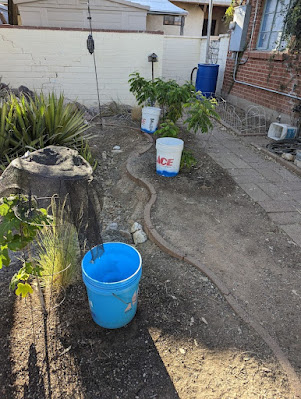I was nervous about going on a two week vacation and leaving my precious plants to be hand watered by a kind neighbor during the hottest month of the year. Our cisterns and water barrels had long since run out of rainwater. In preparation for the trip, I started deep watering all the plants a few days ahead. Dan had read that when the temperture is over 80 degrees that plants can't transpire, so they don't take in water. Since we don't have a drip system, I had to wait until it cooled off in the evening or early morning. I used that time to gather my Zero Waste assessories for our road trip.
For our deep watering we use a method recommended by a local arborist. Dan had drilled two small holes in five gallon buckets. We use three buckets of water on each of our three jujube trees. It takes 20 minutes for each bucket to drain. Luckily, we have three buckets or I would have been there all night. I did that same process with our moringa, pomegranate, fig, and curry plants. The day before we left, I even watered our cactus garden, agaves, and an acacia that hadn't started to leaf yet. On the night before we left, I used the hose to slow water our Mexican Honeysuckle that usually get our sink rinse water everyday.
Meanwhile, I took pictures of our plants to include in the directions for our neighbor (which included filling the bird bath.) I didn't get much sleep that night worrying about my plants and all that water! I guess you can call me a parachute plant parent. And I still had to plant my sweet potato slip in the morning!
After a lovely family vacation, I finally got the nerve to text our neighbor to see how things were doing. She said the plants were doing well. She enjoyed two tasty cherry tomatos. Whew!
When we got home three days later, I was shocked to find that Tucson was under an excessive heat warning!
One of the tomato plants was looking pretty sad (despite having several tomatoes on it.) Our mint plant that was struggling before the trip was now dead along with some tomato volunteers. (Mint never makes it in our yard... Go figure...) Some of the leaves on our sunchokes were a little crispy. Oddly, our moringa had flowers. Usually they get flowers after they are really big. And one of them was really struggling.
After 12 hours on the road, I stayed up late watering my emaciated plants.
I was actually surprised to find that the sweet potato plant was flourishing with new leaves (in the compost under the bird netting cage.)
And the curry and some of the tomatoes were doing just fine. Thanks to my kind neighbor! Of course our native plants were doing great. The acacia now has leaves, and the mesquite has lots of pods. I was surprised to see how well the jujubes were doing. All three have lots of little fruit! Maybe those shiny leaves make it durable?
Since I got home I've been kind of sleep deprived, staying up late and getting up early trying to water the plants in my garden before it reaches 80 degrees. It was 78 degrees at 5:30 this morning! When am I supposed to water them?!! We haven't even washed our dirty clothes from the trip yet because the greywater irrigates the fig and pomegranate and we don't want to waste that water if they aren't taking it in.
When I decided to write this blog, I figured I'd reach out to some gardening experts on Facebook.
I heard that plants can't take in water after the temperature reaches 80 degrees. With this extreme heat way into the night, how are you watering your plants? Also, are there some plants (heritage figs and pomegranate or native trees maybe) that have adapted to take in water after 80 degrees?









Thank you for a good presentation and a very well laid out plan about watering and for sharing your experience. Watering my plants is also my biggest worries when I have to go for any length of time.
ReplyDeleteI am resorting in bringing fragile potted plans inside where it is cooler.
Where do you find ollas at a reasonable price? Have you thought of burying plastic buckets with holes towards the roots next to a plant, Cheaper than ollas but Ollas are best.
I use sweat pipes in my veggie garden and keep the faucet on a slow drip all the time , it keeps soil moist and I use a thick layer of straw that partly insulated from the heat and keeps the humidity towards the ground. I believe in mulch.